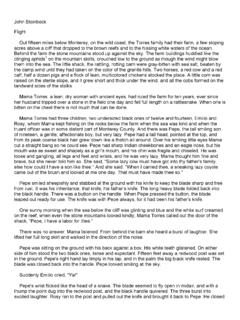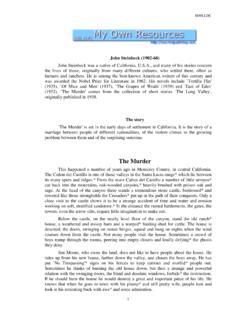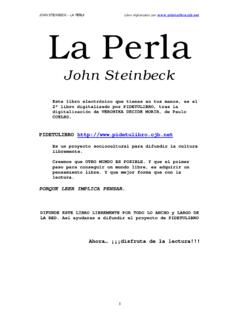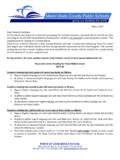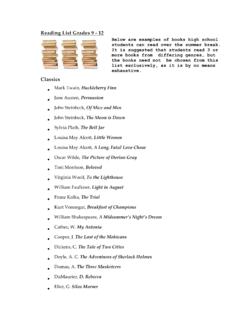Transcription of JohnSteinbeck
1 John steinbeck steinbeck redirects here. For other people with thissurname, seeSteinbeck (surname).John Ernst steinbeck , Jr.(February 27, 1902 De-cember 20, 1968) was an American author of twenty-seven books, including sixteen novels, six non-fictionbooks, and five collections of short stories. He is widelyknown for the comic novelsTortilla Flat(1935) andCannery Row(1945), the multi-generation epicEast ofEden(1952), and the novellasOf Mice and Men(1937)andThe Red Pony(1937). ThePulitzer Prize-winningThe Grapes of Wrath(1939), widely attributed to be partof theAmerican literary canon,[2]is considered Stein-beck s masterpiece. In the first 75 years since it was pub-lished, it sold 14 million copies.[3]The winner of the 1962 Nobel Prize in Literature, he hasbeen called a giant of American letters .[4]His works arewidely read abroad and many of his works are consideredclassics of Western of steinbeck s work is set in southern and cen-tral California, particularly in theSalinas Valleyand theCalifornia Coast Rangesregion.
2 His works frequently ex-plored the themes of fate and injustice, especially as ap-plied to downtrodden Early lifeJohn Ernst steinbeck , Jr. was born on February 27,1902, inSalinas, California. He was of German, En-glish, and Irish descent.[5]Johann Adolf Gro steinbeck , steinbeck s paternal grandfather, had shortened the fam-ily name to steinbeck when he emigrated to the UnitedStates. The family farm inHeiligenhaus,Mettmann,North Rhine-Westphalia, Germany, is still today named Gro steinbeck . His father, John Ernst steinbeck , served asMontereyCountytreasurer. John s mother, Olive Hamilton, a for-mer school teacher, shared steinbeck s passion for read-ing and writing.[6]The Steinbecks were members of theEpiscopal Church,[7]although steinbeck would later be-come an agnostic.[8] steinbeck lived in a small rural town,no more than a frontier settlement, set in some of theworld s most fertile land.[9]He spent his summers work-ing on nearby ranches and later with migrant workers onSpreckelssugar beet farms.
3 There he became aware ofthe harsher aspects of migrant life and the darker sideof human nature, which supplied him with material ex-pressed in such works asOf Mice and Men.[9]He alsoexplored his surroundings, walking across local forests,fields, and farms.[9]While working at Spreckels SugarCompany, he would sometimes work in their laboratory,which gave him time to write.[10]He also had consid-erable mechanical aptitude and fondness for making hisown repairs to things he owned.[10]TheSteinbeck Houseat 132 Central Avenue,Salinas, California,theVictorianhome where steinbeck spent his graduated from Salinas High School in 1919and went from there to study English Literature atStanford UniversityinPalo Alto, leaving, without a de-gree, in 1925. He travelled to New York City wherehe took odd jobs while trying to write. When he failedto have his work published, he returned to Californiaand worked in 1928 as a tour guide and caretaker[10]atLake Tahoe, where he met Carol Henning, his firstwife.
4 [6][10][11]The two were married in January 1930 inLos Angeles, where, with friends, he attempted to makemoney manufacturing plastermannequins.[10]When their money ran out six months later, Steinbeckand Carol moved back toPacific Grove, California, to acottage owned by his father, on theMonterey Peninsulaa few blocks from the border of the city ofMonterey,California. The elder Steinbecks gave John free housing,paper for his manuscripts, and from 1928, loans that al-lowed him to write without looking for work. During thisperiod of theGreat Depression, steinbeck bought a smallboat, and later claimed that he was able to live on the fishand crab that he gathered from the sea, as well as freshvegetables from his garden and local farms. When thatdidn't work, steinbeck and his wife were not above get-ting welfare, or rarely even stealing bacon from the localproduce market.[10]Whatever food they had, they wouldshare with their friends.[10]Carol became the model for122 CAREERMary Talbot in steinbeck s novelCannery Row.
5 [10]In 1930, steinbeck metEd Ricketts, who became aclose friend and mentor to steinbeck during the followingdecade teaching him a great deal about philosophy andbiology.[10]Ricketts, usually very quiet, yet likable, withan inner self-sufficiency and an encyclopedic knowledgeof diverse subjects, became a focus of steinbeck s atten-tion. Ricketts had taken a college class fromWarder , a biologist and ecological theorist, who would goon to write a classic early textbook on ecology. Rickettsbecame a proponent of ecological thinking, in which manwas only one part of a great chain of being, caught in aweb of life too large for him to control or understand.[10]Meanwhile, Ricketts operated a biological lab on thecoast of Monterey, selling biological samples of small an-imals, fish, rays, starfish, turtles, and other marine formsto schools and the years 1930 to 1936, steinbeck and Rick-etts became close friends. steinbeck s wife began work-ing at the lab as secretary-bookkeeper.
6 [10] steinbeck him-self began helping out on an informal basis.[10]Theyformed a common bond based on their love of musicand art, and John learned biology and Ricketts ecologi-cal philosophy.[10]When steinbeck had emotional upsets,Ricketts would sometimes play music for him.[10]2 WritingSteinbeck s first novel,Cup of Gold, published in 1929,is loosely based on the life and death ofprivateerHenryMorgan. It centers on Morgan s assault and sacking ofthe city ofPanama, sometimes referred to as the 'Cup ofGold', and on the women, fairer than the sun, who weresaid to be found there.[12]AfterCup of Gold, between 1930 and 1933 Steinbeckproduced three shorter Pastures of Heaven,published in 1932, consists of twelve interconnected sto-ries about a valley near Monterey, which was discov-ered by a Spanishcorporalwhile chasing runawayIndianslaves. In 1933 steinbeck publishedThe Red Pony, a 100-page, four-chapter story weaving in memories of Stein-beck s childhood.
7 [12]To a God Unknown, named after aVedic hymn,[10]follows the life of ahomesteaderand hisfamily in California, depicting a character with a primaland pagan worship of the land he works. Although hestill had not achieved the status of a well-known writer,he never doubted that he would achieve greatness.[10] steinbeck achieved his first critical success withTortillaFlat(1935), a novel set in post-war Monterey, Califor-nia, that won the CaliforniaCommonwealth Club's GoldMedal.[12]It portrays the adventures of a group of class-less and usually homeless young men in Monterey afterWorld War I, just before They are por-trayed in ironic comparison to mythic knights on a questand reject nearly all the standard mores of American soci-ety in enjoyment of a dissolute life centered around wine,lust, camaraderie and petty theft. In presenting the 1962 Nobel Prize to steinbeck , the Swedish Academy cited spicy and comic tales about a gang ofpaisanos, asocialindividuals who, in their wild revels, are almost carica-tures ofKing Arthur s Knights of the Round Table.
8 Ithas been said that in the United States this book came asa welcome antidote to the gloom of the then prevailingdepression. [1]Tortilla Flatwas adapted as a1942 filmof the same name, starringSpencer Tracy,Hedy LamarrandJohn Garfield, a friend of steinbeck s. With some ofthe proceeds he built a summer ranch-home inLos began to write a series of California novels andDust Bowlfiction, set among common people duringtheGreat Depression. These includedIn Dubious Battle,Of Mice and MenandThe Grapes of Mice and Menwas adramaabout the dreams of apair of migrant agricultural laborers in California. It wascritically acclaimed[12]and steinbeck s 1962 Nobel Prizecitation called it a little masterpiece .[1]Its stage pro-duction was a hit, starringWallace Fordas George andstarringBroderick Crawfordas George s companion - thementally childlike but physically powerful itinerant farm-hand Lennie. steinbeck refused to travel from his homein California to attend any performance of the play dur-ing its New York run, telling directorGeorge S.
9 Kaufmanthat the play as it existed in his own mind was perfect and that anything presented on stage would only be a dis-appointment. steinbeck would write two more stage plays(The Moon Is DownandBurning Bright).Of Mice and Menwas also adapted as a1939 Hollywoodfilm, withLon Chaney, Lennie (he had filled therole in the Los Angeles stage production) andBurgessMeredithas George.[13]Meredith and steinbeck becameclose friends for the next two decades.[10]Another filmbased on the novella was made in 1992 starring GarySinise as George and John Malkovich as followed this wave of success withThe Grapesof Wrath(1939), based on newspaper articles about mi-grant agricultural workers that he had written in San Fran-cisco. It is commonly considered his greatest work. Ac-cording toThe New York Times, it was the best-sellingbook of 1939 and 430,000 copies had been printed byFebruary 1940. In that month it won theNational BookAward, favorite fiction book of 1939, voted by membersof theAmerican Booksellers Association.
10 [14]Later thatyear it won thePulitzer Prize for Fiction[15]and it wasadapted as a film directed byJohn Ford, starringHenryFondaas Tom Joad; Fonda was nominated for the bestactor Academy controversial. steinbeck sNew Dealpolit-ical views, negative portrayal of aspects of capitalism,and sympathy for the plight of workers, led to a backlashagainst the author, especially close to home.[16] 1940s 1960s work3ing the book was both obscene and misrepresented con-ditions in the county, theKern CountyBoard of Supervi-sorsbanned the bookfrom the county s publicly fundedschools and libraries in August 1939. This ban lasted un-til January 1941.[17]Of the controversy, steinbeck wrote, The vilification ofme out here from the large landowners and bankers ispretty bad. The latest is a rumor started by them thattheOkieshate me and have threatened to kill me for ly-ing about them. I'm frightened at the rolling might of thisdamned thing. It is completely out of hand; I mean a kindof hysteria about the book is growing that is not healthy.
